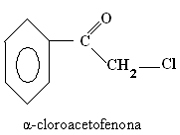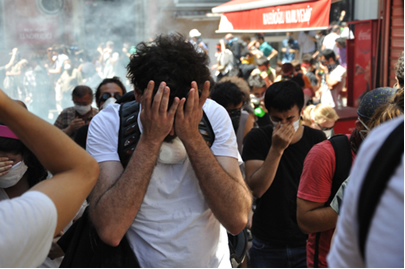The wave of protests against the increase in public transport fares that began in São Paulo and spread to many Brazilian cities has come to be called by many as “Vinegar Revolt”. This term came about because protesters used cloths soaked in vinegar to protect themselves from tear gas released by police officers. They also inhaled or sprayed vinegar on their clothes.
Anyone with vinegar was detained, so they also called the series of marches “Salad Revolt” and “V for Vinegar”.
But is this really true? Does vinegar neutralize the effects of tear gas?
First, let's look at the composition of each one and then check if this is true or myth.
O tear gas is part of the group of organic halides – compounds that have some halogen attached to a carbon chain. You acid halides or acyl halides (group derived from organic halides and the most commonly used as tear gas) are organic compounds that have the following functional group in their structure:

Where “X” is some chemical element from the halogen group (elements from the VII A or 17 family of the Periodic Table, F (fluorine), Cℓ (chlorine), Br (bromine) or I (iodine).
Generally, the Military Police uses as tear gas to α-chloroacetophenone:

Other substances used as tear gas are chloropropanone it's the bromobenzyl cyanide (BBC). Their respective structural formulas are shown below:

The name "tear gas" comes from the Latin tear, which means "tear", which is very appropriate, as this compound causes people to unwittingly want to "cry", that is, strong tearing reactions occur due to the great burning sensation of the endings nervous. It can also cause coughing, burning and vomiting. In people with heart and respiratory problems, tear gas can even lead to death.

Tear gas causes strong tearing reactions and eye irritation[2]
Vinegar is actually an aqueous solution of about 4% by volume of Acetic Acid. Acetic acid or ethanoic acid is an organic compound of the family of carboxylic acids and its structure is shown below:

It was first obtained using ethanol from wine, which oxidizes with oxygen in the air. Hence the origin of its name, as sour wine comes from Latin acetum which means “vinegar”.
When protesters inhale the vinegar, they feel a sense of relief. However, this is momentary and is a very small effect compared to those caused by the gas released by the police. Therefore, there is no scientific proof that vinegar reacts with tear gas, neutralizing it.
This is a myth and can even be harmful to the person, because since vinegar is an acid and all acids are very reactive, vinegar can cause more irritation to the skin, nose and mouth.
Since tear gas has a low toxicity, the irritation or sensory incapacity disappears about 20 to 45 minutes after the person is no longer exposed to this gas. So, the best way to end its effects is move away from the place where the gas has spread, breathe fresh air and remain calm. As for burns, wash your skin with soap and water, in addition to not returning to the place where it was released, as its components remain in the air.

The components of the tear gas released by the police remain in the air[3]
No substance has yet been discovered that completely eradicates tear gas symptoms, but there are some prevention methods that can mitigate its effects:
Skin burns: Physical protector, water paste and products against children's diaper rash can be used.
Burning and tearing of the eyes: Since tear gas reacts with water in the eyes, wearing personal goggles can be of great help. They must be goggles that completely blind the eyes, such as those for motorcyclists, diving and swimming; but they must not be normal glasses or lenses, as in these cases there may be a risk of contamination, because the substances in the gas can become impregnated in them.
Breathing: To aid breathing, ground activated carbon, which is sold in chemical stores, can be used as it has the ability to absorb gases and liquids. It can be placed in a cloth and placed close to the mouth and nose.
Editorial credits for the images:
[1] Anonymous in mask from the movie “V for Vendetta” in protest against the Popular Party's labor reform law in Madrid, Spain, on February 19, 2012: Pedro Rufo /Shutterstock.com;
[2] Clash between protesters and police who used violence and tear gas on June 1, 2013 in Istanbul: Emine Dursun / Shutterstock.com;
[3] Police attack protesters with tear gas and water cannons on June 1, 2013 in Istanbul: fulya atalay /Shutterstock.com.
By Jennifer Fogaça
Graduated in Chemistry
Source: Brazil School - https://brasilescola.uol.com.br/quimica/o-vinagre-neutraliza-gas-lacrimogeneo.htm
